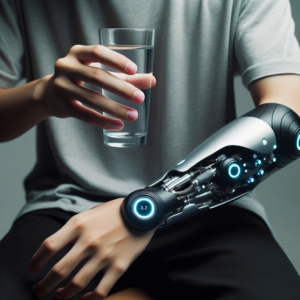Imagine a world where people with limb loss can seamlessly integrate technology into their bodies, enhancing their abilities and enriching their lives. Smart prosthetics, a revolutionary fusion of cutting-edge technology and the human body, are making this vision a reality. These advanced prosthetic limbs are equipped with sensors, microprocessors, and artificial intelligence, allowing users to regain a remarkable level of precision, control, and even sensory feedback. With an increasing number of individuals benefiting from these incredible advancements, smart prosthetics are proving to be a game-changer in the field of prosthetic technology.
The Evolution of Prosthetic Technology
Historical Overview of Prosthetics
Prosthetic technology has a long and fascinating history, dating back thousands of years. The earliest known evidence of prosthetics can be traced back to ancient Egypt, where wooden toes and fingers were discovered on mummies. Over time, advancements in materials and techniques led to the development of more sophisticated prosthetic limbs, such as those used during the Renaissance period. These early prosthetics were often rudimentary and focused primarily on restoring basic functionality.
The Advent of Electronic Prosthetics
The 20th century brought about significant advancements in prosthetic technology, particularly with the invention of electronic prosthetics. These devices utilized electrical signals to help simulate natural movement. The introduction of electricity revolutionized the field, as it enabled prosthetics to better mimic the capabilities of the human body. Electric motors and sensors allowed for more dynamic and precise control over artificial limbs.
The Transition to Smart Prosthetics
In recent years, prosthetic technology has taken yet another leap forward with the emergence of smart prosthetics. Smart prosthetics are a fusion of advanced robotics, artificial intelligence (AI), and cutting-edge materials. These devices represent a significant milestone in the field, as they not only restore lost functionality but also provide enhanced capabilities and a more natural user experience. With the integration of technology, smart prosthetics have the potential to bridge the gap between humans and machines.
Understanding Smart Prosthetics
Definition and Function of Smart Prosthetics
Smart prosthetics are advanced artificial limbs that utilize advanced technologies to provide users with a wide range of benefits. These devices are designed to closely mimic the functionality and appearance of natural limbs, allowing users to perform everyday tasks with ease. The primary function of smart prosthetics is to restore mobility and independence to individuals who have lost a limb, enabling them to engage in activities they may have thought were once impossible.
Key Components of Smart Prosthetics
Several key components work together to make smart prosthetics possible. Firstly, sensors play a crucial role in detecting and interpreting signals from the user’s brain or residual limb. These signals are then processed by a microprocessor, which translates them into precise movements of the prosthetic limb. Motors and actuators provide the necessary power for these movements, while lightweight and durable materials ensure the prosthetic is comfortable and practical for daily use.
Types of Smart Prosthetics
Smart prosthetics come in various forms, depending on the level of amputation and the specific needs of the individual. Some common types include smart hands, which mimic the complex movements of natural human hands, smart limbs, which provide advanced functionality for arm amputees, and smart feet, which allow for natural walking and running. Each type of smart prosthetic is tailored to meet the unique requirements of the user, providing them with a customized solution that suits their lifestyle.
How Smart Prosthetics Work
Smart prosthetics incorporate sophisticated technology to function seamlessly with the human body. The process begins with the collection of sensory information from the user’s body, whether it’s through user inputs or direct neural connections. This information is then transmitted to the prosthetic limb’s microprocessor, where it is analyzed and translated into specific movements. These movements are then executed by the prosthetic limb, enabling the user to control it intuitively, as if it were their own limb.

Influence of Robotics and AI in Smart Prosthetics
Role of Robotics in Prosthetic Technology
The integration of robotics has been instrumental in the advancement of smart prosthetics. Robotics enables the creation of highly precise and adaptable prosthetic limbs that can replicate the complex movements of the human body. By incorporating robotic mechanisms, smart prosthetics can achieve a level of dexterity and functionality that was previously unimaginable. Robotics also allows for the development of prosthetic limbs that can adapt to changing environments and tasks, providing users with a versatile solution for their daily needs.
Introduction to AI in Prosthetics
Artificial intelligence plays a crucial role in smart prosthetics by allowing the devices to learn and adapt to the user’s unique needs and preferences. AI algorithms can analyze and interpret the vast amounts of data collected by sensors and other components, helping to optimize the prosthetic’s performance. By constantly learning from user interactions, AI-powered smart prosthetics can provide a more intuitive and personalized experience, making them feel more like a natural extension of the user’s body.
Combination of AI and Robotics in Smart Prosthetics
The combination of robotics and AI in smart prosthetics is a game-changer, as it allows for a level of functionality and adaptability that was previously unattainable. The integration of AI algorithms enables the prosthetic limb to continuously improve its performance over time, adapting to the user’s specific needs and preferences. This synergy between robotics and AI not only enhances the user’s control over the prosthetic but also provides a more fluid and natural movement, allowing for a more seamless integration of the artificial limb with the user’s body.
Cutting-Edge Innovations in Smart Prosthetics
Notable Technological Breakthroughs
In recent years, there have been several remarkable technological breakthroughs in the field of smart prosthetics. One notable advancement is the development of mind-controlled prosthetics, which allow users to control their artificial limbs through direct neural connections. This groundbreaking technology has the potential to revolutionize the lives of amputees by providing them with a high level of control and precision. Other breakthroughs include the use of advanced materials, such as carbon fiber and 3D printing, which have significantly improved the functionality, comfort, and aesthetics of smart prosthetics.
Current State of the Art
At present, smart prosthetics have reached an unprecedented level of sophistication and functionality. The latest models are capable of performing complex tasks, such as grasping delicate objects with different levels of force and even providing sensory feedback to the user. Some advanced prosthetics can even simulate the sensation of touch through the use of neural interfaces. While there is still room for improvement, the current state of the art in smart prosthetics is a testament to the tremendous progress made in the field.

Impacts of Smart Prosthetics on Quality of Life
Benefits to Mobility and Independence
One of the most significant impacts of smart prosthetics is their ability to restore mobility and independence to individuals who have experienced limb loss. These devices enable users to perform a wide range of activities that would otherwise be challenging or impossible without a functional limb. With smart prosthetics, users can regain their mobility, engage in physical activities, and perform everyday tasks with greater ease and confidence. This newfound freedom and independence have a profound positive impact on the quality of life for amputees.
Psychological and Social Impacts
Smart prosthetics not only have physical benefits but also positively impact users’ psychological and social well-being. The restoration of a functional limb can boost self-esteem and confidence, as individuals no longer feel defined by their disability. Smart prosthetics also help reduce the social stigma associated with amputation, allowing individuals to interact more freely with others and participate in social activities without feeling self-conscious. By enhancing the user’s physical and emotional well-being, smart prosthetics contribute to a more fulfilling and inclusive life.
Real-Life Applications of Smart Prosthetics
Smart Prosthetics in Medicine
Smart prosthetics have found numerous applications in the medical field, beyond the restoration of lost limbs. For instance, they are used in medical training simulations to provide a realistic environment for aspiring healthcare professionals to practice complex procedures. Smart prosthetics are also used in scientific research to study human biomechanics and develop innovative rehabilitation techniques. Additionally, smart prosthetics have become valuable tools in the field of prosthetics research and development, allowing scientists and engineers to test and refine new technologies and techniques.
Use of Smart Prosthetics in Sports and Recreation
Smart prosthetics have opened up new possibilities for athletes and sports enthusiasts with limb loss. These advanced artificial limbs can provide enhanced performance and improved functionality, enabling athletes to compete at higher levels. Sports such as sprinting, cycling, and swimming have seen significant advancements due to smart prosthetics, with notable individuals competing alongside able-bodied athletes. The integration of smart prosthetics in sports and recreation has not only expanded opportunities for athletes but also challenged societal perceptions of disability and redefined the boundaries of human capability.
Personal Stories of Smart Prosthetics Users
The impact of smart prosthetics on individuals’ lives can best be understood through personal stories of users. Countless individuals have shared their experiences of regaining independence, pursuing their passions, and overcoming challenges with the help of smart prosthetics. From accomplished musicians playing complex compositions with robotic hands to athletes pushing themselves to new heights, these stories serve as a testament to the transformative power of smart prosthetics. Through these personal narratives, it becomes evident that smart prosthetics are not merely artificial limbs but life-changing tools that enable individuals to thrive.

Challenges in Smart Prosthetic Technology
Technical and Design Challenges
The development of smart prosthetics is not without its challenges. Technical and design hurdles must be overcome to ensure that these devices meet the needs of users effectively. These challenges include creating prosthetics that are intuitive to control, durable enough to withstand daily use, and capable of providing a natural-feeling limb replacement. The incorporation of complex technologies such as robotics and AI also increases the complexity of the design process, as the prosthetic must seamlessly integrate these components. Additionally, miniaturization and power management of the electronic systems pose ongoing challenges in smart prosthetic technology.
Ethical and Regulatory Issues
The introduction of smart prosthetics raises important ethical and regulatory considerations. Issues surrounding privacy, data protection, and informed consent come into play, as smart prosthetics collect and process sensitive information about the user’s body and movements. Ensuring that the collected data is used appropriately and securely is of paramount importance. Additionally, the regulatory landscape must keep pace with the rapid advancements in smart prosthetics to ensure the safety and efficacy of these devices. Striking the right balance between innovation and regulation is crucial in maximizing the potential of smart prosthetics while safeguarding the interests of users.
Cost and Accessibility Problems
Cost and accessibility remain significant barriers to the widespread adoption of smart prosthetics. The integration of advanced technologies and materials drives up the production cost, making smart prosthetics prohibitively expensive for many individuals. Additionally, limited insurance coverage and lack of reimbursement options further hinder access to these life-changing devices. Addressing these cost and accessibility problems is essential to ensure that smart prosthetics are available to all who can benefit from them. Collaboration between manufacturers, healthcare providers, and policymakers is crucial in finding affordable solutions and expanding access to smart prosthetics for a larger population.
Future Predictions for Smart Prosthetics
Emerging and Potential Smart Prosthetic Developments
The future holds immense promise for smart prosthetics, with many emerging and potential developments on the horizon. Scientists and engineers are exploring the use of advanced materials, such as shape-memory alloys and biocompatible sensors, to enhance the functionality and comfort of smart prosthetics. The integration of neural interfaces and brain-computer interfaces may enable even greater control and intuitiveness, allowing users to operate their prosthetic limbs effortlessly. Additionally, advancements in AI and robotics are expected to continue enabling smarter and more adaptable prosthetic limbs, leading to a new era of human-machine integration.
Speculations on Future Features and Capabilities
Speculations about the future of smart prosthetics abound, with predictions ranging from increased sensory feedback capabilities to the ability to easily switch between multiple prosthetic limbs. Researchers envision prosthetics that can simulate touch, temperature, and proprioception, providing users with a more intuitive and natural experience. The possibility of modular prosthetic designs, where users can attach and detach specialized limbs for various activities, is also an exciting prospect. Furthermore, advancements in regenerative medicine and tissue engineering may pave the way for the development of truly biological prosthetic solutions in the future.

Developers and Manufacturers of Smart Prosthetics
Major Companies and Innovators in the Field
Several major companies and innovators play a pivotal role in the development and advancement of smart prosthetics. Companies such as Össur, Touch Bionics, and Endolite have been at the forefront of smart prosthetic design and manufacture, consistently pushing the boundaries of what is possible. These companies have made significant contributions in areas such as robotic prosthetic hands, advanced control systems, and durable yet lightweight materials. Additionally, collaborations between academic institutions, research labs, and healthcare organizations contribute to the collective efforts in advancing smart prosthetic technology.
New Entrants and Emerging Players
As smart prosthetics continue to gain traction, new entrants and emerging players are entering the market, bringing fresh perspectives and innovations. Start-ups and research labs are exploring groundbreaking ideas, including novel ways of integrating sensors, artificial muscles, and machine learning algorithms into smart prosthetics. These new entrants inject creativity and diversity into the field, stimulating further advancements and fueling competition. The presence of both established manufacturers and new players fosters a robust ecosystem that fosters innovation and drives progress in smart prosthetics.
Contributions to Advancements in Smart Prosthetics
The combined efforts of developers, manufacturers, researchers, and users have propelled the field of smart prosthetics to new heights. Developers and manufacturers continually invest in research and development to introduce novel technological features and improve the overall functionality of smart prosthetics. Collaborations between academia and industry bring together expertise from various fields, stimulating innovation and knowledge exchange. User feedback and involvement are invaluable in shaping the design and performance of smart prosthetics, as their experiences guide future enhancements. The collective contributions of these stakeholders have paved the way for the extraordinary advancements achieved in smart prosthetic technology.
Concluding Thoughts on Smart Prosthetics
Importance of Advancements in Smart Prosthetics
The rapid advancements in smart prosthetics are of utmost importance, as they have the potential to revolutionize the lives of individuals with limb loss. These devices not only restore mobility and independence but also improve the psychological and social well-being of users. The integration of technology with the human body through smart prosthetics blurs the lines between human and machine, enabling a level of functionality and adaptability that was once unimaginable. As smart prosthetics continue to progress, they will undoubtedly redefine what it means to live with a prosthetic limb.
Long-Term Vision for the Field
The long-term vision for smart prosthetics is to create artificial limbs that seamlessly integrate with the human body, providing an experience that is indistinguishable from natural limbs. This vision encompasses the development of prosthetics that not only restore lost functionality but also enhance human capabilities, augmenting physical abilities beyond what is naturally possible. Additionally, the field aims to address the challenges of cost and accessibility, ensuring that smart prosthetics are accessible to all individuals in need. By pursuing these goals, the field of smart prosthetics has the potential to reshape the future of healthcare and redefine the boundaries of human potential.
A Recap of the Transformative Power of Smart Prosthetics
Smart prosthetics represent a remarkable fusion of technology with the human body, empowering individuals with limb loss to regain their mobility, independence, and confidence. From the ancient wooden prosthetics of Egypt to the cutting-edge smart prosthetics of today, the field has come a long way, driven by technological advancements and the unwavering determination to improve the lives of individuals with limb loss. These devices have the power to transform not only the physical capabilities of users but also their psychological well-being and social inclusion. Smart prosthetics are not mere mechanical replacements but life-changing innovations that bridge the gap between human and machine, shaping a more inclusive and empowering future.











